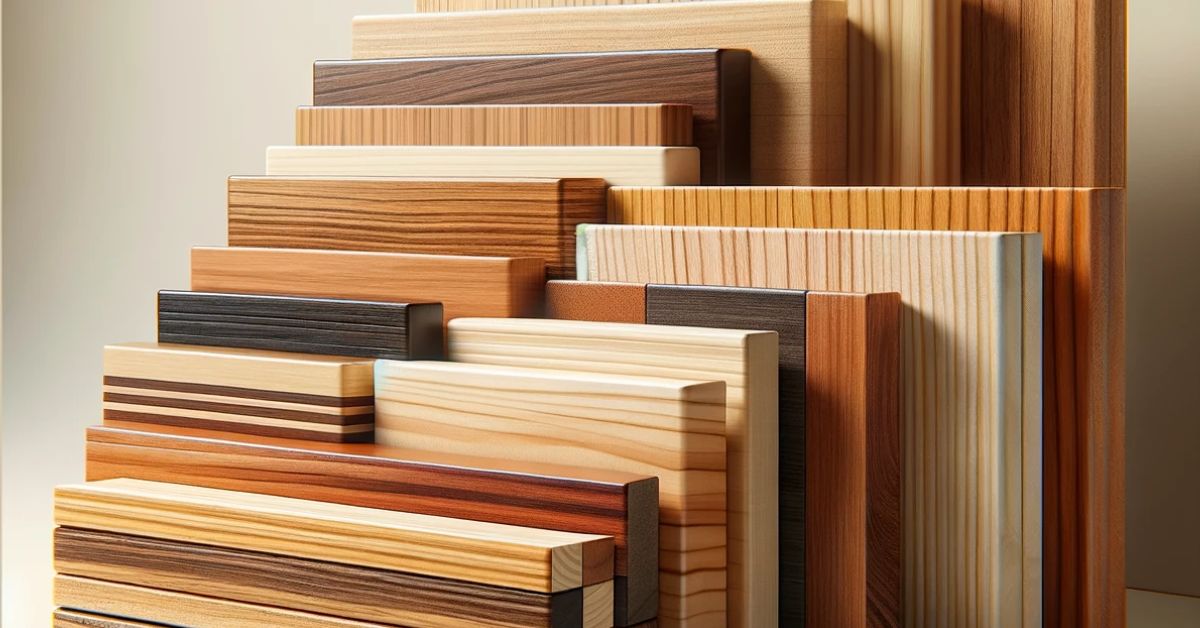This post contains affiliate links.
Choosing the right wood for your desk top is a big decision. This guide is here to help you pick the best wood that looks good and works well for what you need.
Different woods are good for different things. Strong woods like oak wood and maple wood last long, even if you use your desk often. Softer woods, like pine wood, are easier on your wallet and still look nice. Bamboo is a great choice if you want to be kind to the Earth.
Key Takeaways
- For strength and durability, Oak and Maple are unparalleled choices.
- Pine is the go-to for those needing a lightweight desk that’s easy to move.
- Walnut and Cherry offer the most aesthetic appeal with their rich colors and attractive grain patterns.
- Bamboo is the best choice for environmental sustainability.
- When cost is a major factor, Pine offers a budget-friendly solution without compromising too much on quality.
- Maple and Bamboo are excellent for their low maintenance needs, making them practical for busy lifestyles.
When considering the strength and durability of wood for your desk, it’s essential to understand the Janka hardness scale.
What is the Janka Hardness Scale?
The Janka Hardness scale measures the resistance of wood to wear and denting, providing a clear indication of how well the wood can handle the rigors of daily use. It’s also a good indicator of how hard a wood is to saw or nail.
This guide will teach you about all the kinds of wood you can choose from. You’ll learn about how they look and how much care they need. Keep reading to learn more about each type of wood so you can choose the best one for your desk.
1. Oak: Classic and Durable
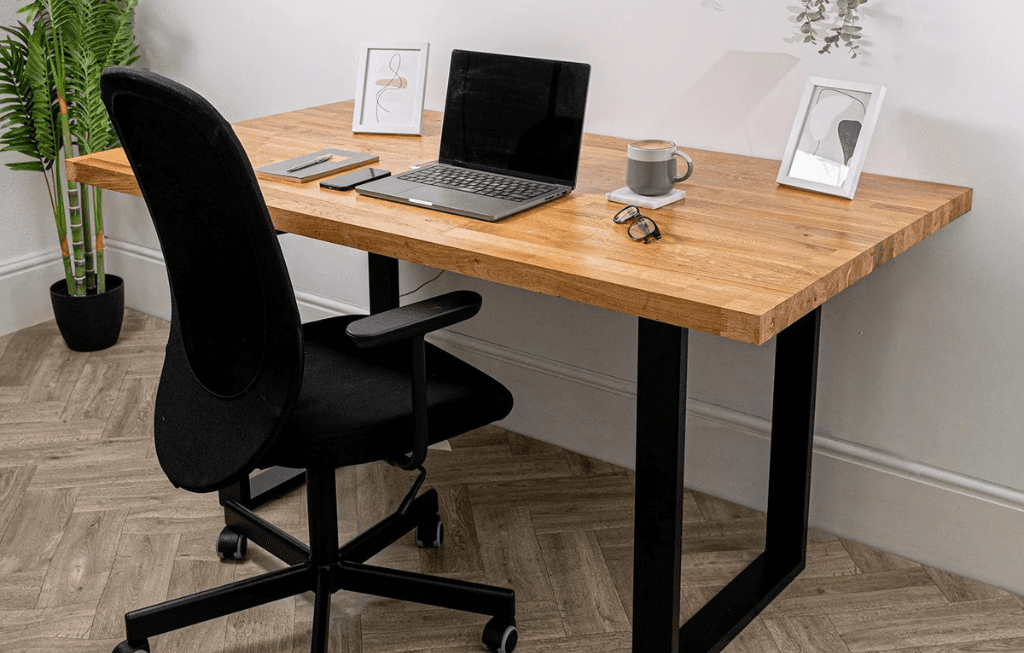
Oak wood, renowned for its strength and durability, is a classic choice for desk tops. Its dense structure makes it resistant to wear and tear, ideal for desks that endure heavy daily use. The pronounced grain patterns of oak add a rugged, distinctive charm, enhancing its aesthetic appeal.
Over time, oak develops a richer patina, adding to its natural beauty and antique allure. It requires minimal maintenance, typically just regular dusting and occasional polishing. Environmentally, oak is a sustainable choice when sourced responsibly, making it appealing to both traditional and eco-conscious users.
| Feature | Highlights |
| Strength & Durability | Excellent – Janka hardness 1360, great scratch resistance |
| Weight & Movement | Heavy, not ideal for frequent repositioning |
| Aesthetic Appeal | Warm honey to reddish brown, prominent grain, classic & rustic |
| Environmental Impact | Not as sustainable as bamboo, but FSC-certified options available |
| Cost | High |
| Maintenance | Moderate – regular cleaning and occasional refinishing |
| Best For | Heavy use, heirloom pieces, formal desks |
2. Maple: Hard and Versatile
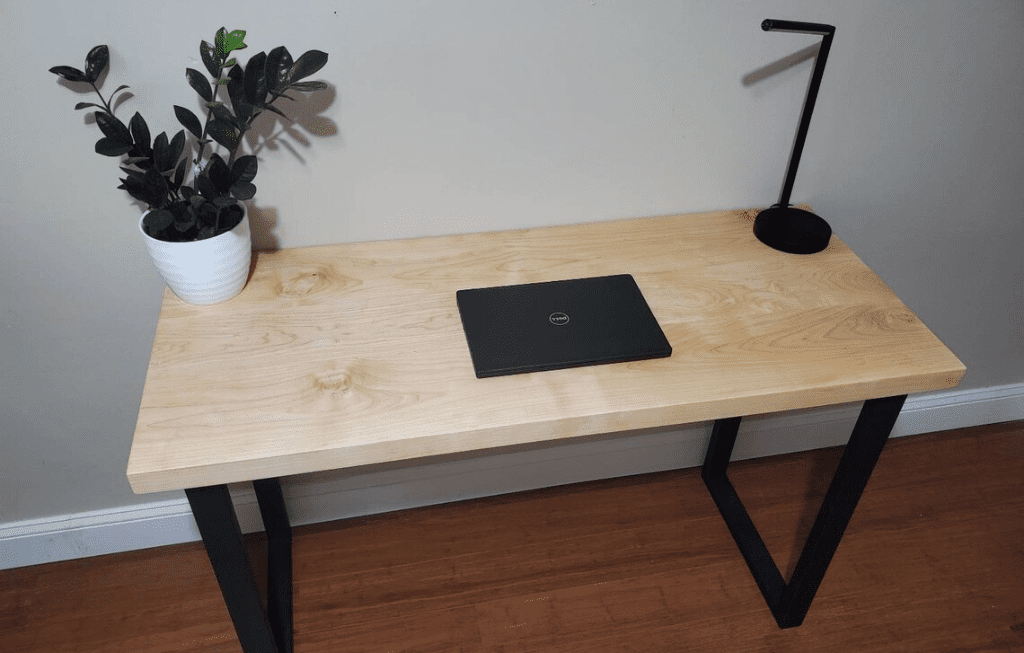
Maple wood stands out for its hard and versatile nature, making it a popular choice for desk tops. Known for its fine, even grain and light natural color, maple offers a clean, contemporary look that brightens any workspace. It’s highly durable, resisting dents and scratches, which is ideal for a frequently used desk.
Maple’s smooth surface is not only visually appealing but also easy to maintain, requiring just simple cleaning to keep it looking pristine. This wood adapts well to various finishes, allowing for customization to match any decor style. Additionally, maple’s consistent texture and strength make it a reliable and stylish choice for a long-lasting desk.
| Feature | Highlights |
| Strength & Durability | Excellent – Janka hardness 1450, highly stable |
| Weight & Movement | Moderately heavy, suitable for most setups |
| Aesthetic Appeal | Light to golden brown, tight grain, modern & contemporary |
| Environmental Impact | Sustainable with FSC-certified options |
| Cost | Moderate |
| Maintenance | Low – easy to clean and maintain |
| Best For | Writing desks, computer desks, high-traffic areas |
3. Pine: Affordable and Lightweight
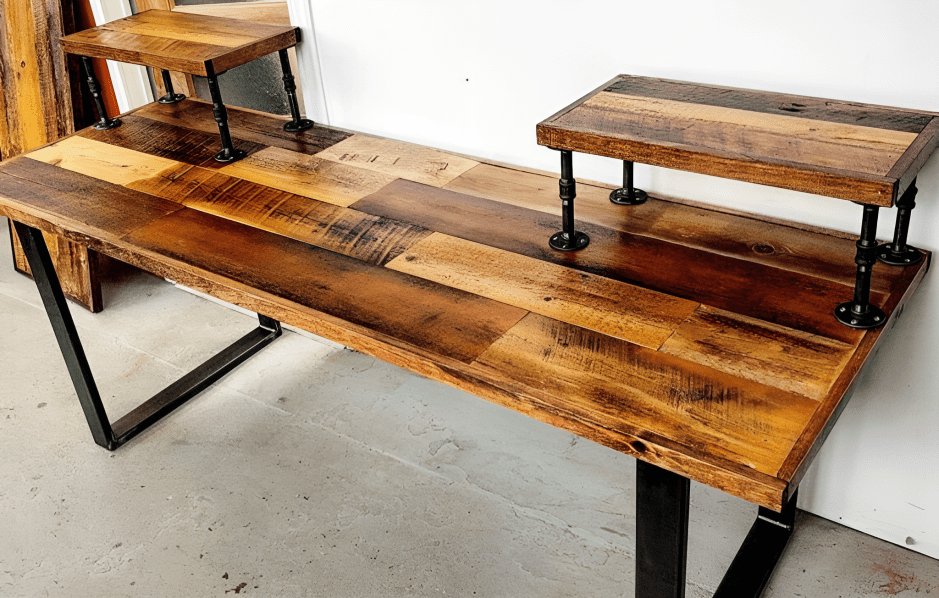
Pine wood, known for its affordability and lightweight nature, is a great option for desk tops, especially for those on a budget. It has a softer composition compared to hardwoods like oak and maple, which makes it easier to handle and shape. Pine’s natural knots and grain patterns give it a rustic, inviting appearance, adding character to any room.
Despite being softer, pine still offers decent durability for everyday use, though it may show wear more quickly than harder woods. Its light weight makes it easy to move, ideal for dynamic workspaces or home offices that frequently rearrange. Pine’s charm lies in its simplicity and natural beauty, making it a cost-effective yet attractive choice for a desk.
| Feature | Highlights |
| Strength & Durability | Good for light use – Janka Hardness 380, moderate scratch resistance |
| Weight & Movement | Lightweight, easy to move and handle |
| Aesthetic Appeal | Pale yellow to creamy white, prominent knots, casual & rustic |
| Environmental Impact | Generally sustainable, readily available |
| Cost | Low |
| Maintenance | Low – easy to clean and maintain |
| Best For | Budget-friendly desks, DIY projects, light use |
4. Walnut: Rich Color and Grain
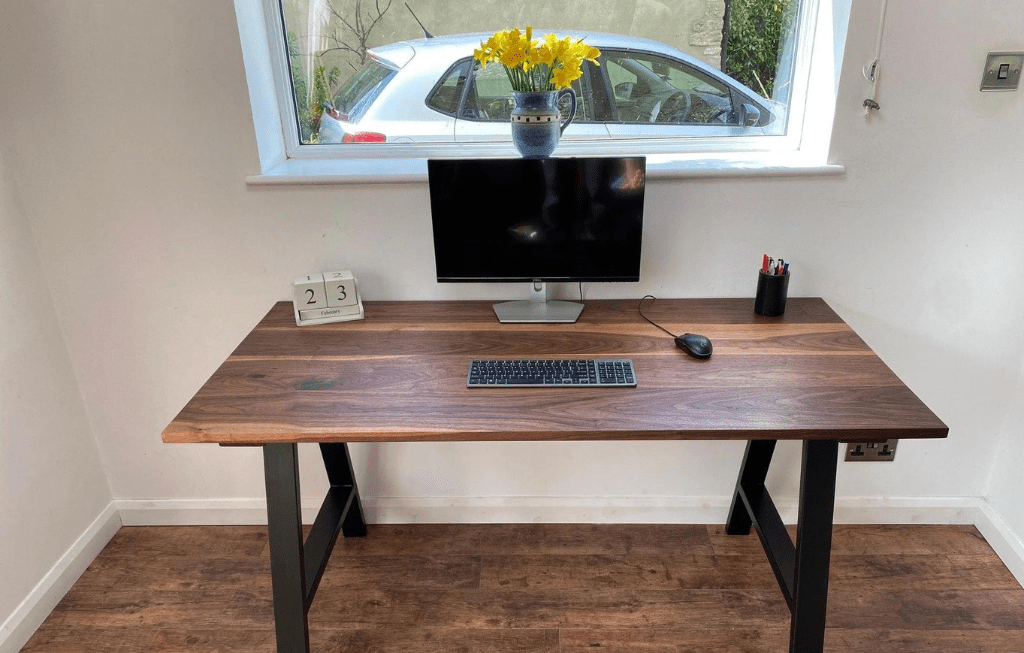
Walnut wood is celebrated for its rich color and elegant grain patterns, making it a premium choice for desk tops. Its deep, chocolate hues and unique, flowing grains bring a sophisticated and luxurious feel to any workspace. Walnut is not just about looks; it’s also durable and strong, capable of withstanding the demands of daily use.
This wood ages gracefully, with its color mellowing to a more refined richness over time, adding to its aesthetic appeal. While walnut is on the higher end of the price spectrum, its combination of beauty, durability, and the timeless elegance it brings to furniture pieces makes it a worthwhile investment for a statement desk.
| Feature | Highlights |
| Strength & Durability | Excellent – Janka hardness 1010, rich and dense |
| Weight & Movement | Heavy, requires extra muscle for repositioning |
| Aesthetic Appeal | Deep chocolate brown, dark streaks, modern & luxurious |
| Environmental Impact | Not as sustainable as bamboo, consider FSC-certified options |
| Cost | High |
| Maintenance | Moderate – regular cleaning and occasional refinishing |
| Best For | Executive desks, statement pieces, modern setups |
5. Cherry: Timeless Elegance
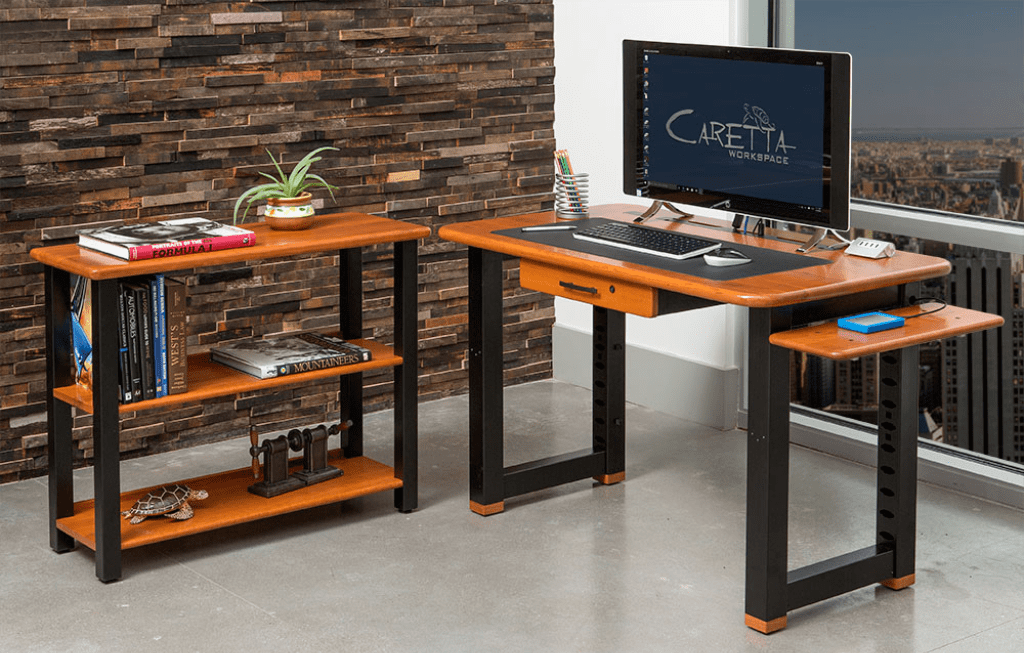
Cherry wood is renowned for its timeless elegance and fine grain, offering a warm and inviting feel to desk tops. It possesses a unique quality where its rich, reddish-brown color deepens and becomes more lustrous with age, adding character and sophistication. Cherry’s smooth texture and straight grain make it a favorite for high-end, classic furniture pieces.
Though not as hard as maple or oak, cherry still provides ample durability for a desk, handling regular use with grace. Its moderate hardness also allows for easier crafting and shaping, making it a popular choice among woodworkers. Cherry wood’s blend of beauty, durability, and the charm of aging gracefully makes it an exquisite choice for a desk that combines functionality with luxury.
| Feature | Highlights |
| Strength & Durability | Excellent – Janka hardness 950, highly scratch-resistant |
| Weight & Movement | Moderately heavy, suitable for most setups |
| Aesthetic Appeal | Rich reddish brown, swirling grain, traditional & elegant |
| Environmental Impact | Not as sustainable as bamboo, consider FSC-certified options |
| Cost | High |
| Maintenance | Moderate – regular cleaning and occasional refinishing |
| Best For | Traditional desks, libraries, home offices |
6. Bamboo: Eco-Friendly and Modern
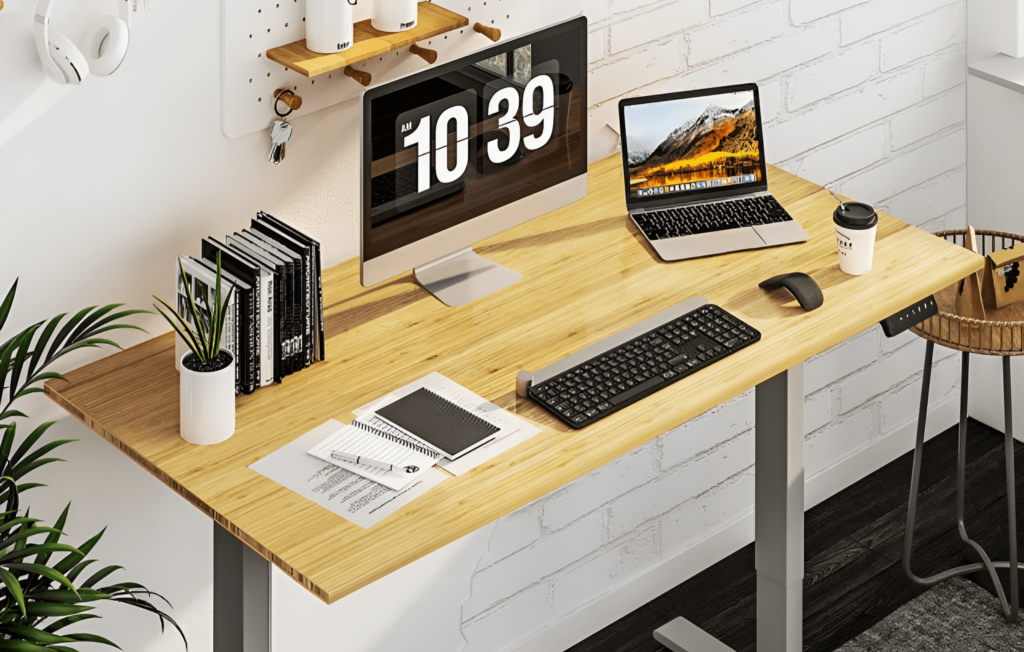
Bamboo stands out as a modern and eco-friendly choice for desk tops. Unlike traditional hardwoods, it’s a highly renewable resource, growing rapidly and requiring minimal resources. Its natural resilience to moisture and stains makes it a practical option for busy workspaces.
In terms of aesthetics, bamboo offers a sleek, contemporary look with its clean lines and uniform grain. It’s lightweight yet surprisingly strong, blending ease of movement with durability. This combination of environmental sustainability, low maintenance, and modern appeal makes bamboo an increasingly popular choice for office furniture.
| Feature | Highlights |
| Strength & Durability | Excellent – Janka hardness 1560, fast-growing & renewable |
| Weight & Movement | Moderately heavy, but lighter than most hardwoods |
| Aesthetic Appeal | Light golden brown, vertical grain, modern & minimalist |
| Environmental Impact | Most sustainable option, eco-conscious choice |
| Cost | Moderate |
| Maintenance | Low – easy to clean and maintain |
| Best For | Eco-conscious spaces, minimalist desks, standing desks |
Factors to Consider When Choosing Wood for Your Desk
When selecting the perfect wood for your desk, several critical factors come into play. Each type of wood offers unique characteristics, and understanding these can help you make a choice that not only meets your aesthetic preferences but also aligns with your practical needs.
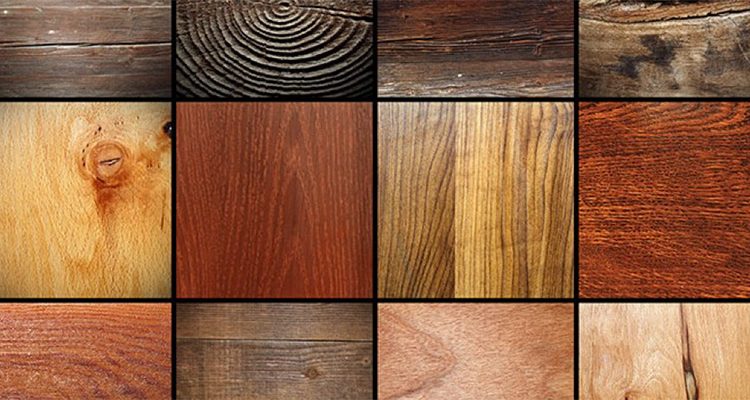
1. Strength and Durability
Durability is paramount when choosing wood for a desk. You want a material that can withstand daily use, resist wear and tear, and maintain its integrity over time.
- Oak is renowned for its strength. An oak desk can last generations, becoming more beautiful with age. According to a furniture expert, “Oak’s dense grain makes it exceptionally sturdy and resistant to warping.”
- Maple is another robust choice. It’s known for its hardness, making it ideal for a workspace that sees a lot of activity.
2. Weight and Ease of Movement
If you anticipate moving your desk frequently, the weight of the wood is a crucial consideration.
- Pine is a lightweight option, making it easy to relocate. This feature is particularly beneficial in dynamic home office setups or in spaces that require frequent rearranging.
- Bamboo, though not a traditional wood, is a great alternative, offering both lightness and strength.
3. Aesthetic Appeal and Grain Patterns
The look of your desk can influence the ambiance of your workspace. The grain pattern and color of the wood play a significant role in its aesthetic appeal.
- Walnut is prized for its rich, deep color and unique grain patterns, often described as “elegantly rustic.”
- Cherry wood, with its fine grain and warm hues that deepen over time, offers a classic look that many find appealing.
4. Environmental Impact and Sustainability
With growing environmental concerns, the sustainability of the wood is an important factor.
- Bamboo stands out as an eco-friendly choice. It’s a highly renewable resource, with a much faster growth cycle than traditional woods.
- Certified sustainable woods like FSC-certified oak or maple ensure that your desk choice is not contributing to deforestation.
5. Cost Considerations
Budget is often a deciding factor in choosing wood for a desk.
- Pine is cost-effective and widely available, making it a popular choice for those on a budget.
- Walnut and Cherry are on the higher end of the price spectrum but offer unmatched elegance and longevity.
6. Maintenance Requirement
The amount of upkeep required to keep your desk looking its best is also worth considering.
- Maple and Bamboo require minimal maintenance. They are resistant to stains and easy to clean, making them ideal for busy or multi-use spaces.
- Oak and Cherry require more care, such as regular oiling, to maintain their appearance and durability.
Finishing Your Wood Desk Top
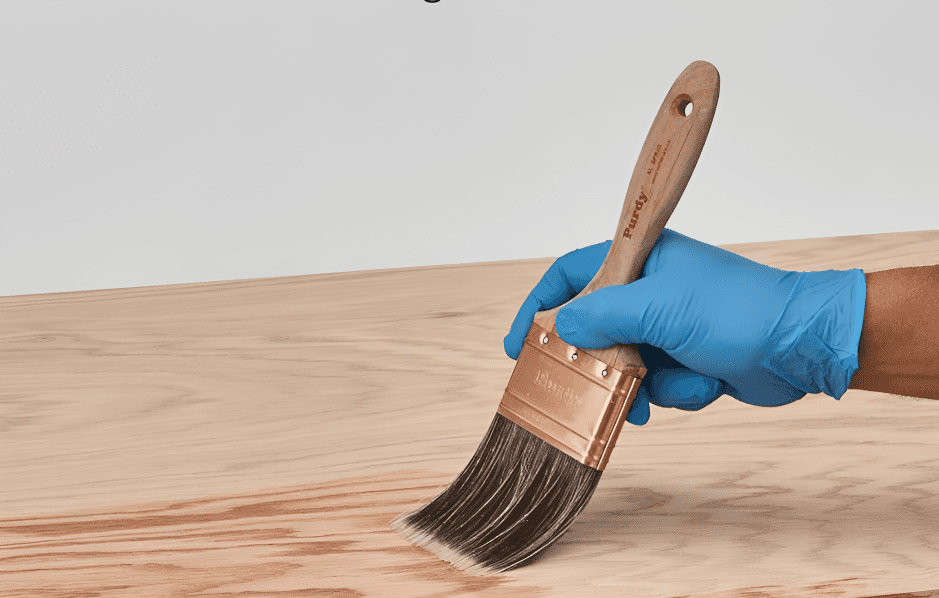
Once you’ve selected the perfect wood for your desk, the next step is to finish it. This means applying certain products to the wood edges to protect them and make them look nice. The finish you choose can transform it from just a piece of furniture to a reflection of your style.
- Clear Coat: If you love the natural look of wood, go for a clear coat like this one. It’s like giving your desk a protective yet invisible shield, allowing the natural grain and color to shine through.
- Wood Stain: If you’re looking to add a hint of color while maintaining the wood’s natural charm, a wood stain is your go-to option. Available in various shades, wood stain like this Minwax Oil-Based Wood Stain adds depth and character to your desk top.
- Paint: For a big change, paint’s the way to go. It’s like giving your desk a brand-new outfit that matches your room perfectly. It’s perfect for aligning your desk with the specific color scheme of your home office.
If you’re finishing the wood yourself, here are some tips:
- Sand the wood first to get rid of any rough spots.
- Apply the finish with a brush or cloth, following the direction of the grain.
- Let it dry completely before using the desk.
Before You Go…
Each type of wood has its own set of strengths that cater to different needs. When making your final decision, consider how much you’re willing to spend, how much effort you’re ready to put into maintenance, and what you’ll use the desk for.
If you enjoyed learning about different types of wood desk top, you’re going to love my other article. It’s a guide that shows you how to design your own desk on the internet. You can pick colors, styles, and all sorts of things without even leaving your chair!
How To Customize Your Desk Online: Easy and Affordable Guide

